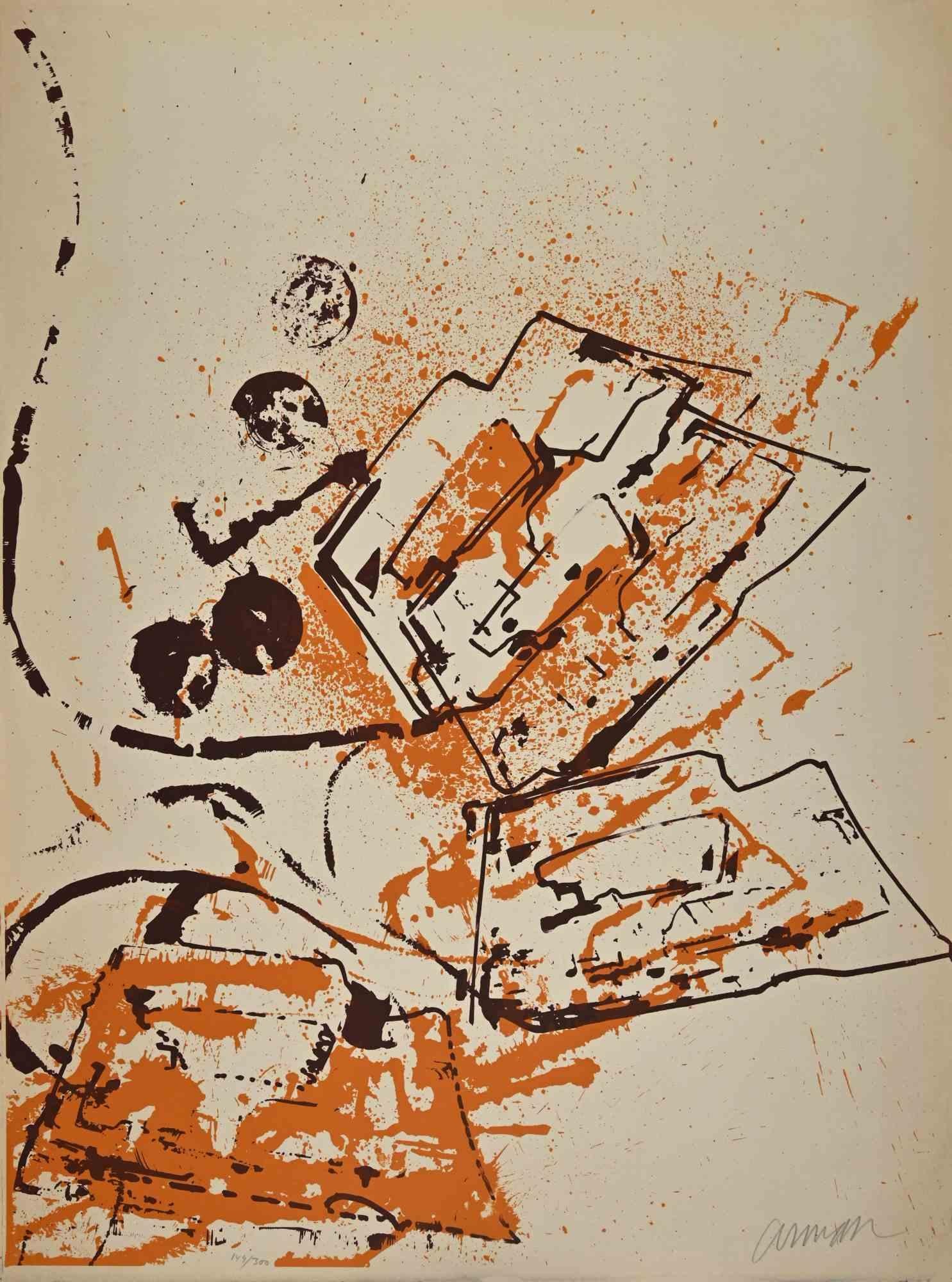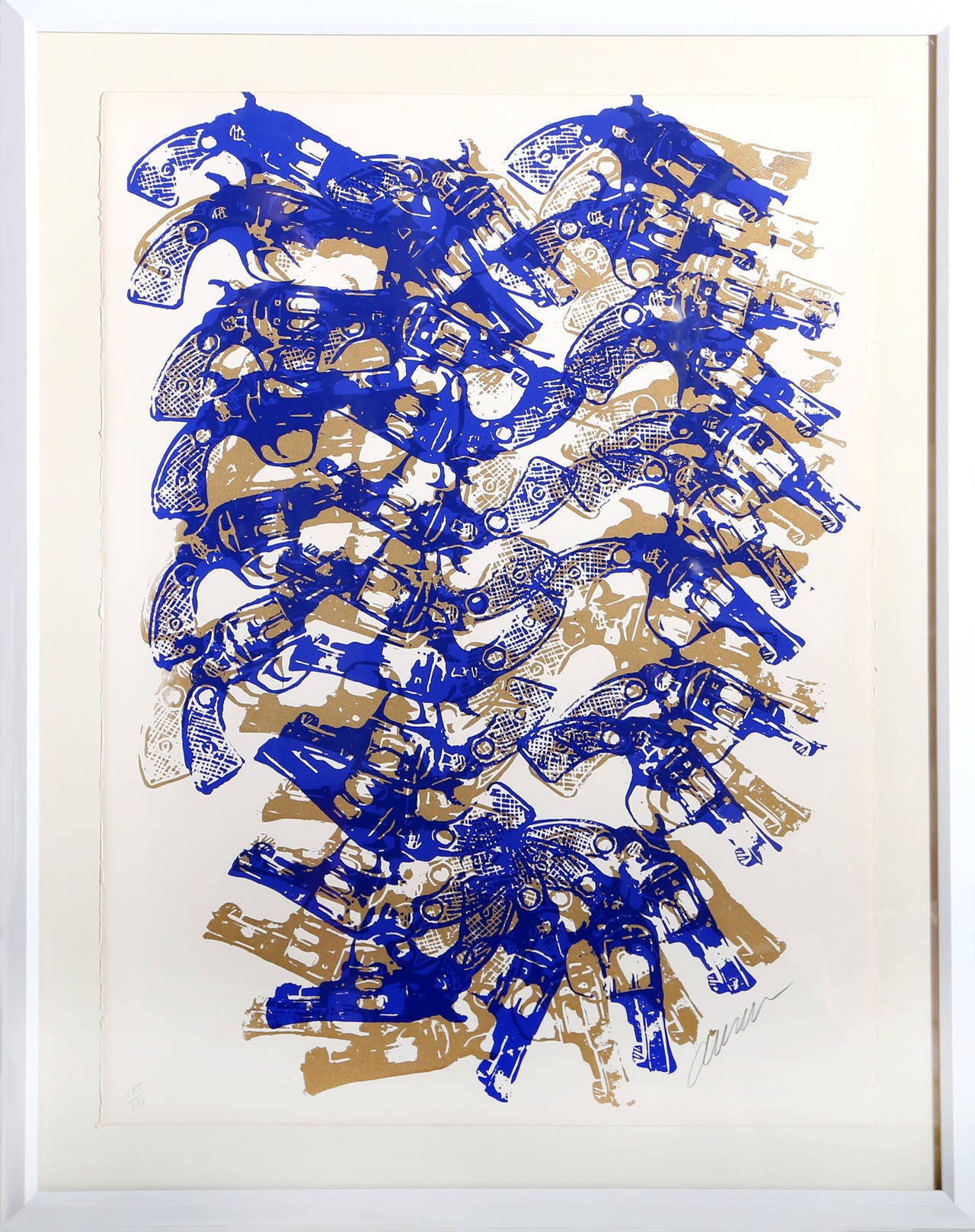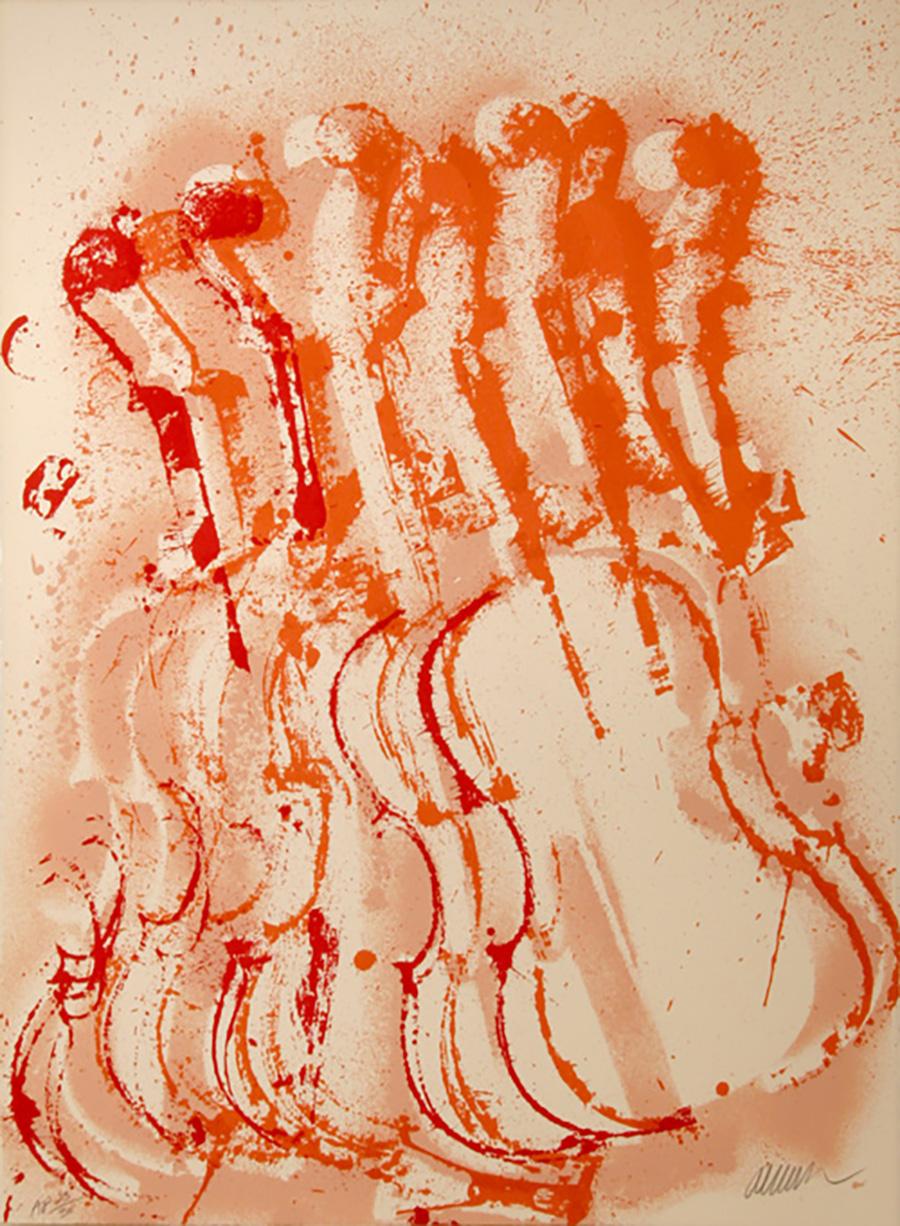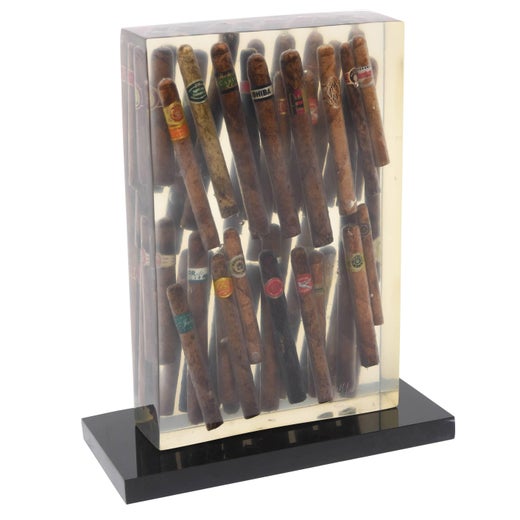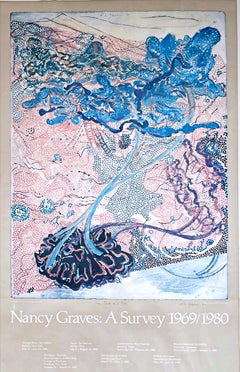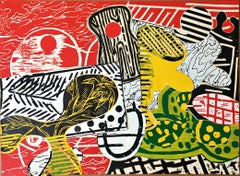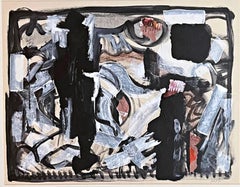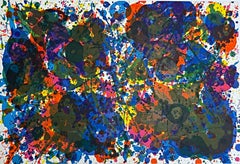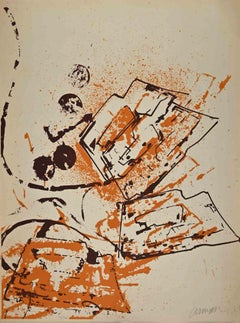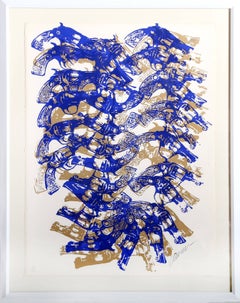Items Similar to Boom Boom (Guns) mid century print, New York International portfolio S/N 1960s
Want more images or videos?
Request additional images or videos from the seller
1 of 8
ArmanBoom Boom (Guns) mid century print, New York International portfolio S/N 1960s1965
1965
$1,000
£756.85
€868.64
CA$1,424.58
A$1,544.99
CHF 811.49
MX$18,766.57
NOK 10,154.51
SEK 9,561.04
DKK 6,487.76
About the Item
Arman
Boom Boom (unique variation from New York International Portfolio), 1965
Screenprint with pencil additions.
Pencil signed and numbered 12/225 on the front
Published by Chiron Press, bearing their blindstamp front
Provenance: Acquired from the original New York International Portfolio
17 × 22 inches
Edition of 225
Unframed
While this silkscreen and stencil print is from an edition of 225, each print is unique because the hand stenciled gun is placed differently on each image: "The artist drew guns on the silkscreen from which the prints were made. Each has an additional hand-stenciled gun for uniqueness and variety.The many revolvers, in accumulation, become so many horse heads. They gambol like the hills of the palm. Claes Oldenburg's ray guns of 1959 are evoked, as are Arman'e own accumulations of spectacles ans high heeled shoes. Silver and gold guns - aluminum and brass - take the light differently from the black and single red.Black silhouette, simple outline, 'arbitrary' smudge and continuous hatching are ways in which the gun is drawn. The effect is lively, not death-dealing." (from the portfolio introduction by Henry Geldzahler). The present work is the hand signed and numbered screenprint with unique pencil variations from the New York International portfolio, (which also featured work by Willi (Mary) Baumeister, Robert Motherwell, Oyvind Fahlstrom, John Goodyear, Charles Hinman, Allen Jones, Ad Reinhardt, James Rosenquist and Saul Steinberg.) Excerpt from the MOMA catalogue featuring this print: "Accumulation and repetition are the hallmarks of the work of Nouveau Realiste artist Arman. In common with the art of other members of this loosely defined Paris-based group, Arman's work signaled the return of interest in the industrialized urban environment after the predominance of abstract painting. His inventive constructions incorporate numerous manufactured goods, such as shoes, car parts, violins and paint tubes. Eschewing the personal artistic mark, Arman began making rubber stampings in 1955, which, by the end of the decade, evolved into his tracings - impressions on canvas made by objects dipped in paint. Revolvers have been a constant motif in Arman's work, beginning with the accumulation Boom!Boom! of 1960 and appearing as recently as 1979 in Tools of Persuasion. Other objects of violence, including sabers and gas masks, also appeared in the early 1960s work. During this period, Arman began his aggressive actions titled Coleres or Tantrums, which included dynamiting a car and smashing a cello on stage. This period of violent motifs, reflects in part, Arman's wartime experiences and coincides with the increased tension in Paris over the Algerian war. (1956-1962).
Arman was inspired by the prints of Jasper Johns that he saw on his first trip to New York in 1961. Among Arman's earliest prints are several lithographs and monotypes composed of repeated renderings or imprints of an object. In 1966, Rosa Esman of Tanglewood Press invited him to participate in her portfolio New York International. After the success of her first publishing venture, New York 10, Esman chose to work with an international roster of artists, many of whom had successful exhibitions in New York that season. More established artists, such as Robert Motherwell and Ad Reinhardt, were also included.
More about Arman
I specialize very much in… everything,” the French-born American artist Arman told an interviewer in 1968. “I have never been — how do you say it? A dilettante.” Regarded as one of the most prolific and inventive creators of the late 20th century, Arman’s vast artistic output ranges from drawings and prints to monumental public sculpture to his famous “accumulations” of found objects. His work—strongly influenced by Dada, and in turn a strong influence on Pop Art—is in the collections of such institutions as the Metropolitan Museum of Art in New York, the Tate Gallery in London and the Centre Pompidou in Paris.
Born in Nice in 1928, Armand Pierre Fernandez showed a precocious talent for painting and drawing as a child. (Inspired by Vincent van Gogh, he signed his early work with his first name only; he retained a printer’s 1958 misspelling of his name for the rest of his career.) The son of an antiques dealer and amateur cellist, the artist absorbed an intense appreciation for music, the art of collecting and the cultivation of discriminating taste from an early age. After studies at the Ecole Nationale des Arts Décoratifs in Nice, Arman decamped to Paris to study art history at the Ecole du Louvre. His work in these early years focused on abstract paintings inspired by the work of Nicolas de Staël. An avid reader, Arman sought inspiration through books and art reviews, as well as during frequent road trips throughout Europe with his artist friends from Nice, Claude Pascale and Yves Klein.
Arman
Arman was born in Nice, France, in 1928, and showed a talent for painting and drawing as a child. He studied at the the Ecole Nationale des Art Décoratifs in Nice followed by studies at the École du Louvre in Paris. In his early years he focused on abstract paintings. Then, in 1957, he became interested in common objects as works of art. He first did what came to be called his "allures d"objet" (object impressions), where he would dip an object into paint and press it on canvas thus leaving the object's shadow or impression. Then he decided the object itself was worth paying attention to and started to treat them in his own way. His intention was to remove the material purpose of an object so that its only remaining function was to "feed the mind" as a work of art. What better way to achieve that result than by breaking, slicing or even burning objects such as violins, telephones, typewriters or even whole cars? He also made objects useless by accumulating them, such as 2,000 wristwatches in a Plexiglass box that all kept different time. Once emotionally detached from the circumstances associated with a broken object, the viewer could grow to appreciate its abstract beauty; so, in a sense, Arman was literally teaching that things one never thought could be regarded as attractive could indeed turn out to be so. Through this achievement, Arman gained worldwide recognition and is regarded as one of the most prolific and inventive creators of the late 20th century. His work can be found in the collections of numerous museums including the Metropolitan Museum of Art in New York, the Tate Gallery in London and the Centre Pompidou in Paris. Arman’s work has also been exhibited in galleries, museums and public spaces worldwide including the Musée D’Art Contemporain in Tehran, Iran; the Museum of Art in Tel Aviv, Israel; the Musée Des Arts Decoratifs and Opéra De Paris in France; the La Jolla Museum of Contemporary Art in California; and the Museum of Arts and Design and the Guggenheim in New York He died in 2005 in New York.
About the Seller
5.0
Gold Seller
Premium sellers maintaining a 4.3+ rating and 24-hour response times
Established in 2007
1stDibs seller since 2022
455 sales on 1stDibs
Typical response time: 2 hours
- ShippingRetrieving quote...Shipping from: New York, NY
- Return Policy
Authenticity Guarantee
In the unlikely event there’s an issue with an item’s authenticity, contact us within 1 year for a full refund. DetailsMoney-Back Guarantee
If your item is not as described, is damaged in transit, or does not arrive, contact us within 7 days for a full refund. Details24-Hour Cancellation
You have a 24-hour grace period in which to reconsider your purchase, with no questions asked.Vetted Professional Sellers
Our world-class sellers must adhere to strict standards for service and quality, maintaining the integrity of our listings.Price-Match Guarantee
If you find that a seller listed the same item for a lower price elsewhere, we’ll match it.Trusted Global Delivery
Our best-in-class carrier network provides specialized shipping options worldwide, including custom delivery.More From This Seller
View AllRare offset lithograph poster (signed and inscribed to founder, Tallix Foundry)
By Nancy Graves
Located in New York, NY
Nancy Graves
Nancy Graves: A Survey 1969/1980 (Hand signed and inscribed to Dick Polich of Tallix), 1980
Offset lithograph poster (hand signed, dated and inscribed)
signed, dated and...
Category
1980s Abstract Expressionist Abstract Prints
Materials
Offset
Squash scarce Abstract Expressionist woodcut print, Signed/N, top female artist
By Judy Pfaff
Located in New York, NY
Judy Pfaff
Squash, 1985
Woodcut on wove paper
Signed, numbered 78/85, dated and titled on the front with artist's and publisher's blind stamps.
21 3/4 × 29 3/4 inches
Publisher
Cente...
Category
1980s Abstract Expressionist Abstract Prints
Materials
Woodcut
Mid century Modern 1960s Abstract Expressionist painting, renowned artist Signed
Located in New York, NY
Jack Wolfe
Untitled, 1965
Acrylic and collage on board
Hand signed on the front
Frame included: held in original vintage frame with original gallery label
Unique
Provenance: Parker Street 470 Gallery, Boston, Mass (with label verso)
Excellent abstract expressionist mixed media work.
Measurements:
Image:
17" x 24"
Framed:
24" x 28" x 1"
From Wiki:
Jack Wolfe (14 January 1924 – 18 November 2007) was a 20th-century American painter most known for his abstract art, portraiture, and political paintings. Jack Wolfe was born in Omaha, Nebraska on January 14, 1924, to Blanche and Everett L. Wolfe. Soon after his birth, his family moved to Brockton, MA. At 18, Wolfe had an interest in commercial illustration, which he pursued at the Rhode Island School of Design (RISD). However, upon matriculating at RISD in 1942, he developed an interest in fine art and painting inspired by an exhibition of modern French art. He described this change of direction, explaining that, "One day, for the first time, I saw an exhibition of modern French art. It was like being struck by lightning." He became particularly interested in the work of a number of European modernists, including Rouault, Cézanne, Braque, Modigliani, and Picasso.[1] Following his time at RISD, he pursued a Master’s in Fine Arts degree at the Museum of Fine Arts School in Boston, MA. At the Museum School, Wolfe studied under the renowned Expressionist Karl Zerbe, a German-born artist who was the Museum School's most influential and vital teacher until 1953.[2] After graduating from the Museum School, Wolfe was represented by the Margaret Brown Gallery in Boston, which also represented many other cutting edge Moderns that defied the more conservative tastes of New England collectors at the time, including György Kepes, Congur Metcalf, and Alexander Calder.[3]
Career and Museum Representation
Jack Wolfe's painting "Robin's Rock" 1962, 72" x 72"
Jack Wolfe's artwork received early recognition from a number of organizations and was consistently featured in influential exhibitions, including the 1955 Carnegie International at the Carnegie Institute in Pittsburgh, PA, the American Federation of Art's traveling exhibition New Talent in the USA in 1956-57, the Whitney Museum’s Young America exhibition in 1957,[4] the Boston Institute of Contemporary Art's Selection exhibition in 1957,[5] and both the Whitney Museum’s 1958 Annual exhibition and its Forty Artists Under Forty show in 1962-63.[6] In 1959, his widely acclaimed Portrait of Abraham Lincoln toured Europe in a show circulated by the Institute of Contemporary Art, Boston. In addition, his painting Crucifixion was chosen by the United States Information Agency to be exhibited across Europe, including being shown at the Salzburg Biennial in Austria in 1958.[7] Crucifixion was also exhibited at the Whitney Museum and subsequently displayed in the National Cathedral in Washington, DC, in 1958.[8] In 1966-67, his work was selected for Art for Embassies by the U.S. State Department.[9] He received the first annual Margaret Brown Memorial Award for high achievement by a New England Artist from the Institute of Contemporary Art, Boston, in 1958.[10]
With his future as one of the great artists of his time laid out neatly before him, Wolfe moved to New York in the early 1950s, which was then the postwar epicenter of the art world and in the midst of experiencing the first real revolution in American Art, now known as Abstract Expressionism.[11] However, almost immediately upon his arrival, he became disenfranchised with the overtly commercial nature of the art scene there, spurning fame and security in an unwillingness to bend his creative vision to the expectations of others.[12] After four short months, he left New York, returned to Massachusetts where he bought property in Stoughton, cleared the land, and built both his home and studio with his own two hands. He would go on to live and paint there, extensively exhibiting and garnering constant critical acclaim.[13]
Wolfe became one of the earliest artists championed by the deCordova Museum in Lincoln, MA and the Institute of Contemporary Art in Boston. He was awarded a traveling scholarship in 1958,[6] which allowed him to set up studio in San Miguel de Allende, Mexico and then in San Francisco, California.[14] Upon his return in 1959, the deCordova museum hosted Wolfe’s third solo exhibition, featuring work made during his time in California...
Category
1960s Abstract Expressionist Abstract Paintings
Materials
Mixed Media, Acrylic, Gouache, Permanent Marker
Untitled Abstract Expressionist lithograph, from Carnegie Museum (155 Lembark)
By Sam Francis
Located in New York, NY
Sam Francis
Untitled (from Fresh Air School), 1972
Lithograph on wove paper, for the Carnegie Museum of Art
15 × 22 inches
Limited Edition of 6,000 (unsigned edition; there is a sepa...
Category
1970s Abstract Expressionist Abstract Prints
Materials
Lithograph
Cleve Gray Abstract Expressionist color band - rare silkscreen signed & numbered
By Cleve Gray
Located in New York, NY
Cleve Gray
Untitled, 1970
Silkscreen
Boldly signed and numbered 32/100 in graphite pencil by Cleve Gray on the front
30 × 22 1/2 inches
Signed and numbered 32/100 by artist on the fr...
Category
1970s Abstract Expressionist Abstract Prints
Materials
Screen
Pull Out All Flags, iconic Abstract Expressionist etching aquatint, SIgned 33/50
By Robert Motherwell
Located in New York, NY
Robert Motherwell
Pull Out All Flags (Engberg, Banach 263), 1980
Aquatint and etching in colors, on German Etching paper, with full margins
Hand-signed by artist, Pencil signed and n...
Category
1980s Abstract Expressionist Abstract Prints
Materials
Etching, Aquatint
You May Also Like
Abstract Composition - Lithograph by Arman - 1980s
By Arman
Located in Roma, IT
Abstract Composition is a contemporary artwork realized by the French Artist Arman (Armand Pierre Fernandez) in 1980s.
Mixed colored lithograph on paper. Hand signed on the lower ri...
Category
1980s Abstract Abstract Prints
Materials
Lithograph
Bloody Guns, Pop Art Screenprint by Arman
By Arman
Located in Long Island City, NY
Artist: Arman, French (1929 - 2005)
Title: Bloody Guns
Year: 1979
Medium: Serigraph, signed and numbered in pencil
Edition: 150, AP 30
Size: 30 in. x 22 in. (76.2 cm x 55.88 cm)
Category
1970s Dada Figurative Prints
Materials
Screen
Western Accumulation, Abstract Pop Art Screenprint by Arman
By Arman
Located in Long Island City, NY
Artist: Arman, French (1929 - 2005)
Title: Western Accumulation
Year: 1979
Medium: Silkscreen on Arches Paper, signed and numbered in pencil
Edition: 150, AP 30
Size: 30 in. x ...
Category
1970s Contemporary Abstract Prints
Materials
Screen
Cavalcade, Signed Abstract Screenprint by Arman
By Arman
Located in Long Island City, NY
Artist: Arman
Title: Cavalcade
Year: 1979
Medium: Silkscreen on Arches, signed and numbered in pencil
Edition: 150, AP 30
Paper Size: 25 x 39 inches
Category
1970s Pop Art Still-life Prints
Materials
Screen
Royal Guns, Abstract Screenprint by Arman
By Arman
Located in Long Island City, NY
Artist: Arman, French (1929 - 2005)
Title: Royal Guns
Year: 1979
Medium: Serigraph on Arches, signed and numbered in pencil
Edition: 150, AP 30
Size: 30 x 22 in. (76.2 x 55.88 cm)
Category
1970s Conceptual Figurative Prints
Materials
Screen
Music with a Flair, Pop Art Silkscreen by Arman
By Arman
Located in Long Island City, NY
Artist: Arman
Title: Music with a Flair
Year: 1979
Medium: Silkscreen on Arches, Signed and Numbered in Pencil
Edition: 150, AP 23/30
Size: 30 in. x 22 in. (76.2 cm x 55.88 cm)
Category
1970s Abstract Still-life Prints
Materials
Screen
